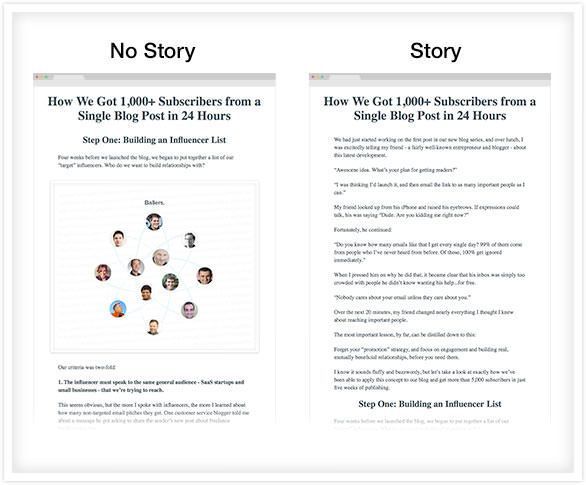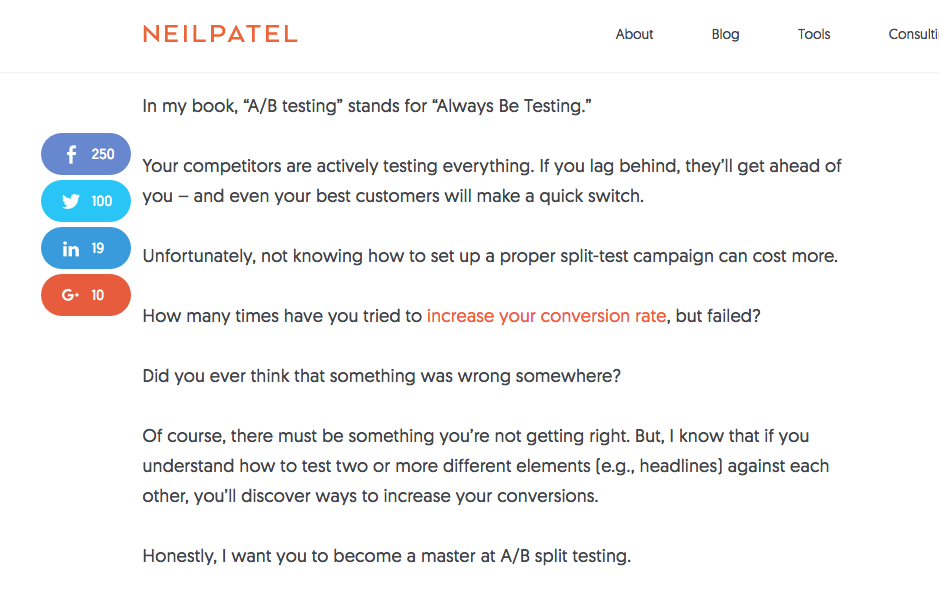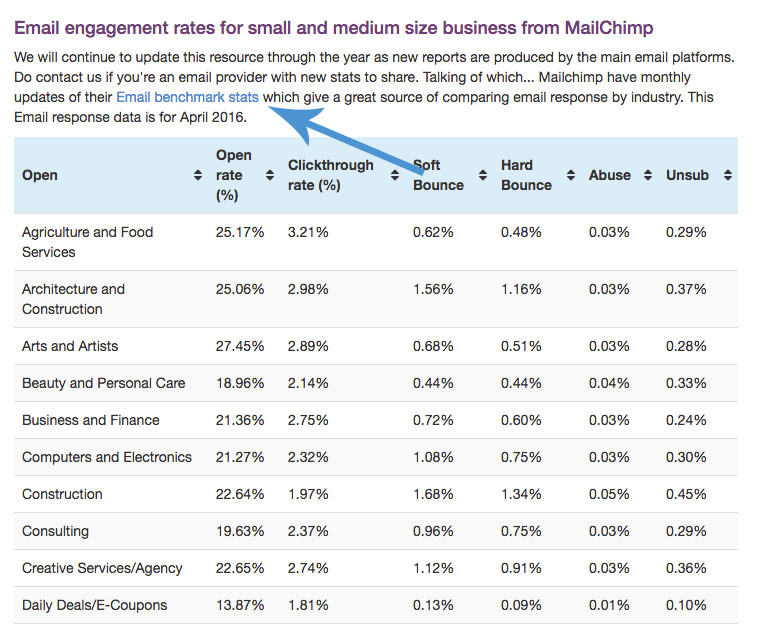This post originally appeared on the Wishpond Blog. Wishpond is a marketing platform that enables marketers to generate, nurture, and manage leads.
13 Research-Backed Ways to Get More Social Shares
Do you want more social shares on your articles?
Some marketers might argue that social shares are a vanity metric that have no bearing on your bottom line.
But even they couldn’t deny the value of the increased reach and exposure that comes with increased social engagement.
If you’re interested to know exactly what those changes were, I’ve compiled 13 tricks to help you create more shareable content.
Enjoy!
A strong headline can make or break a blog post, regardless of the content. It’s been recommended that bloggers spend up to 80% of their time writing headlines (which seems crazy, right?).
But even if you’re not ready to devote that amount of time to coming up with a headline, there are still some best practices you can apply to help ensure that the time you spent writing the article isn’t wasted. Those are:
- Use numbers when possible
- Try and keep your headlines between 6-8 words
- Use emotional and power words
For help coming up with a high performing headline, try using Co-Schedule’s headline analyzer.
We’ve even compiled some power words for you to use here:

Never underestimate the power of a good headline, it can make or break your article.
Sharable Content Trick #2: Tell a Story
Alex Turnbull, CEO of Groove, wrote a guest post on the Buffer blog explaining the power of story in consumable content.
In it he revealed an A/B test he ran on a piece of content, one without a story, and a variation with a story as an introduction.

What he found was that the number of people who scrolled to the bottom on the story variation was 300% higher, and the average time on page was over five times as much.
Logic would follow that the more people that read your content, the more people that can potentially get value out of it and share it.
Remember, it doesn’t matter how good your post is if no one gets a chance to read it.
Sharable Content Trick #3: Write for Middle Schoolers
Unless you’re writing academic papers, there’s no need to write at a university level, ever.
In fact, a study by Contently showed that most of the best selling authors of our time write around an 8th grade reading level.
Authors include:
- Seth Godin: Grade 7.5
- Malcolm Gladwell: Grade 8.5
- Sheryl Sandberg: Grade 7.5
- JK Rowling: Grade 7.5
- Tim Ferriss: Grade 8
- Jim Collins: Grade 10
- Shane Snow: Grade 8.5
Simplifying your writing makes content easier to read, easier to understand, and more likely to be shared.
Don’t believe me?
Well when’s the last time you shared an academic journal on social media?
Didn’t think so.
Pro Tip: For a quick snapshot of what grade level you’re currently writing at, try a tool like Hemmingway app to determine what’s easy to read, and what you can change.
Sharable Content Trick #4: Use Short Sentences
On the internet, short sentences work better. That’s a fact.
This might be something difficult to get your head around, especially if were trained to write in university.
To test this theory, take an inventory of all of your favorite bloggers and ask…
How long are their average sentences?
How many sentences do they usually write before going to a new paragraph?
What you’ll probably find is that most professional bloggers that receive a lot of social engagement write in a very short and concise manner.
Marketer Neil Patel suggests never exceeding three sentences per paragraph and always starting a sentence rather than using a comma.
Take a look at one of Neil’s posts:

Notice how most of his sentences are a single line?
Use this strategy to increase the readability of your content and therefore the number of people who will make it to the end to share it.
Sharable Content Trick #5: Give Readers Social Currency
People share content for 6 reasons. Those are based on:
- Social currency: what makes us look good
- Triggers: things that are top of mind
- Emotion: something that makes us feel something
- Public: what people around us are doing
- Practical value: things that are useful
- Stories: something with a good narrative
Now content that you create doesn’t have to match all of those categories, but hitting on at least one of those points can help to incentivise social sharing.
One easy technique is to embed social currency into your post. You can do this by creating content that resonates with your audience and will make them look like good by sharing.
Take a look at one of my recent posts that incorporated social currency:

Take notice of the title “9 Struggles Only a Digital Marketer Would Understand“.
At a glance marketers can quickly identify with the title, and might be inclined to share as it reinforces their sense of self: being a marketer.
It also places them in an exclusive group of people that “get it”.
So now think to yourself, how can you position your content in a way that acts as social currency for your readers?
Pro Tip: For more information on social currency, check out Jonah Berger’s article How to Make Your Content Go Viral.
Sharable Content Trick #6: Make your Content Insanely Useful
Before you get too excited about renaming one of your blog posts to integrate social currency, there is one caveat: your content should be insanely useful and actionable in order to live up to the hype.
There’s a term for changing a headline to generate more clicks without changing the underlying content to match the new expectation, and that’s clickbait.
To avoid this, try and infuse as much value as you can into your articles in the form of:
- Free downloads
- Relevant and useful links
- Key takeaways
- Actionable advice
An awesome example of this is from Groove’s blog where they not only lay out a plan of attack for their readers, but they also offer a link to an additonal resource.

By clicking on an inline CTA, users are then brought to a templated Google Sheets version of the plan to help users get started.

The key point to remember is that people should be able to read your content and immediately go and implement the strategies your recommend.
Sharable Content Trick #7: Make it Easy to Share
This might sound obvious, but if you want people to share something, you need to make it easy for them to share. And there’s nothing better to encourage this than built-in share buttons on a blog.
At Wishpond we use Sharaholic, but there’s a number of services which function in a similar way. If you have a WordPress site you can install share button plugins, otherwise there’s a number of places to get some HTML code to get your share buttons up and running.
They are:
I’m a believer that the specific tool that you use isn’t the most important thing. Ensuring that your content is easy to share is.
Pro Tip: If you’re looking to display the total number of Twitter shares on a blog post, consider using TwitCount since Twitter’s deactivated displaying the number of Tweets on a post.
Sharable Content Trick #8: Write it as a List
List posts are the some of most shareable content online today. And that’s partially due to the fact that lists appeal to the part of our brain that likes to categorize things, it breaks down complex topics into small bite size pieces and gives us the ability to scan and pull out key points that resonate with us.
It’s no wonder that when searching for content, you’ll find that list posts dominate the landscape of most shared content.

Writing your posts as a list doesn’t mean you’re simplifying your content either, in fact, list posts require you to organize your ideas more clearly ahead of time in order to ensure easy deliverability to your readers.
If you want to get started with list posts, the easiest place to start is to think of “best of” or “worst of” posts. This can include things like:
- Strategies
- Locations
- Events
- Tools
For example, this post is written as a list post. Rather than positioning it as “How to Create Shareable Content”, we’ve broken it down as “13 Tricks For Remarkably Sharable Content”..
How can you start using list posts in your content?
Sharable Content Trick #9: Tag Your Content for Social Sharing
So imagine this, you’ve produced some good content, a user has received value from it and is now ready to share it on social.
What’s next?
Assuming you’ve installed some social share buttons they can click “Tweet,” share the post and away they go.
It’s that simple right?
Not quite! A simple mistake that a lot of content creators make is neglecting to add relevant hashtags and forgetting to @mention brands and influencers referenced in their article.
Take a look at this example from our article 100 Marketing Growth Hacks Learned from 5 Years as a Startup. Under this tip we included a “Tweet This” button in order to make it easy for people to share this tip on Twitter.

Once they click “Tweet This” a pre-populated tweet is brought up:

In that Tweet the company used in the example is mentioned (Buffer) as well as a relevant hashtag for the article.
Taking the time to @mention and tag your share messages with the relevant tags is a quick win for added engagement and reach on social.
To add a inline Tweet feature like the one in the example above, check out Click to Tweet.
Sharable Content Trick #10: Leverage Current Events
No matter what industry you’re in, there’s always going to be new updates, releases, and industry-wide events that are going to grab people’s attention.
Take advantage of those events by creating content tailored to a specific audience interested in hearing the story unfold.
At Wishpond, we recently started writing about industry-wide events. This includes things like Instagram and Facebook’s algorithm updates, developments with Snapchat, AdWords announcements, etc.
One such article was an article my colleague Jordan wrote about Facebook’s News Feed Algorithm Update.

Articles like this are a great way to leverage current events in order to score more social shares and engagement.
Pro Tip: To stay on top of current events, regularly check sites like Feedly to get a big picture overview of what’s going on in your industry.
Other great examples of this can include references made to current events in pop culture.
Take a look at this article by promoter.io written about NPS ratings:

In it they leveraged the popularity of the show “Strange Things” on Netflix in order to create a blog header image that could resonate with their target audience.
Sharable Content Trick #11: Create Emotion
Studies have shown that your content has to have an emotional effect on readers especially if you want them to share it.
But this isn’t limited to positive emotions such as joy, love or optimism.
In fact, negative emotions have been shown to have an equal or even greater effect on the overall shareability of a post if it penetrates deep enough into a user’s psyche and drives them to take action.
Take a look at an article from Business Insider that discoussed the possibility of video views being stolen from YouTube creators on Facebook.

The post itself went viral, but what’s even more interesting than the number of shares was the reaction different YouTube influencers and supporters had to the post.


This is just one example of how you can use emotion to drive social engagement and shares.
Be warned however, writing emotionally-driven content can sometimes backfire, especially if you’re catering to negative emotions such as anger and terror.
The content team at Fractl did a study of top shared content from the image site imgur and found that there were 5 main emotions that consistently came up again and again. They were:
- Curiosity
- Amazement
- Interest
- Astonishment
- Uncertainty

For more on how you can create different types of emotional content, check out Neil Patel’s article 8 Ways to Get More Social Shares Without Annoying Readers.
Sharable Content Trick #12: Use Buzzsumo to Identify Shareable Blog Topics
Rather than shooting in the dark to determine what types of content will perform well in the future, take a lesson from the history books and look through Buzzsumo to see which content performed well in the past.
Take a look at the search results for the keyphrase “landing page optimization”.

Taking stock of what’s already been produced and highly shared will help you hone in on what types of topics are popular, and how you can create similar, equally shareable, content.
The trick is to find popular posts that you can expand on and provide either more advanced strategies, more actionable examples, better data, or simply a more thorough analysis.
Another perk of using this strategy is that since you’re choosing topics based around posts that have already been published, there’s already data on who’s engaged with and shared those posts.
This comes in handy, especially when it comes to doing outreach for your new article.
To see who’s shared a particular article, click “View Shares”.

This will reveal a targeted list of users who you can be sure will find value out of your new article.

Pro Tip: Especially if you’re just starting out, nothing beats getting your hands dirty with some good old fashioned outreach — particularly when new blog traffic is your primary objective.
Use Buzzsumo’s list of sharers as a starting point for this outreach.
Sharable Content Trick #13: Publish (Really) Original Content
Generally speaking, if you want to create something that generates a lot of shares, you either need to:
- Create something substantially more valuable than what already exists (think Brian Dean’s skyscraper technique)
- Relate to current events
- Trigger an emotional response (i.e. cute, inspiring, angry, controversial)
- Create original content
Interestingly enough, creating original content is the easiest of the four. And that’s because original content is based on your own experiences, unique perspective, and data.
This can fall into three broad categories:
- How we did “x”
- Findings from “x” data
- Story of “x”
The problem that most people make is repurposing pre-existing content and then assuming that it’s original content.
Yes you could say it’s original in the sense that you might have given your own unique perspective on the topic or because you categorized the data in a different way. But if you’re not creating your own story, or publishing your own data, then you’ll always be sourcing back to the original article or publisher.
Here’s an example of an unoriginal article linking back to the original source.

Compare this with the original Mailchimp article that now receives both linkbacks and shares.

Creating original content doesn’t need to be super data driven either. Take a look at this example from the Groove blog that discussed how adding one-on-one meetings helped improve their company culture.

By looking for your own stories and data, you step into the ranks of the original content creators that need not link back and source their findings, because they’re the true original.
Once you’ve discovered this you’ll find that you have the monopoly on your story and the social engagement that follows.
Summary
There’s no one secret to creating sharable content, but there are a number of tactics that you can employ to increase the likelihood that someone will share.
As a litmus test of shareability, the next time you create a piece of content consider; if I read this would I want to share it?
If the answer is no (and you feel that your representative of someone in your space), then it might be time to reconsider your topic, add more value, and embed more elements of shareability into your post.
To recap, those are:
- Develop a strong headline
- Tell a story
- Write for middle schoolers
- Use short sentences
- Give readers social currency
- Make your content insanely useful
- Make it easy to share
- Write it as a list
- Tag your content for social sharing
- Leverage current events
- Create emotion
- Use Buzzsumo to identify shareable blog topics
- Create (really) original content
This is author biographical info, that can be used to tell more about you, your iterests, background and experience. You can change it on Admin > Users > Your Profile > Biographical Info page."
About FunnelGrowth
We are a digital marketing company with a focus on helping our customers achieve increase their sales across all online channels.
Request a free quote
Is your company's marketing not getting the results you need or you need help executing a new campaign? Contact us to schedule a FREE 30 minute strategy session.
Recent Posts
- The Importance Of Good Web Hosting September 17, 2019
- Why You Need Google Reviews For Your Local Business September 3, 2019
- Making A Content Strategy For Your Business August 20, 2019

